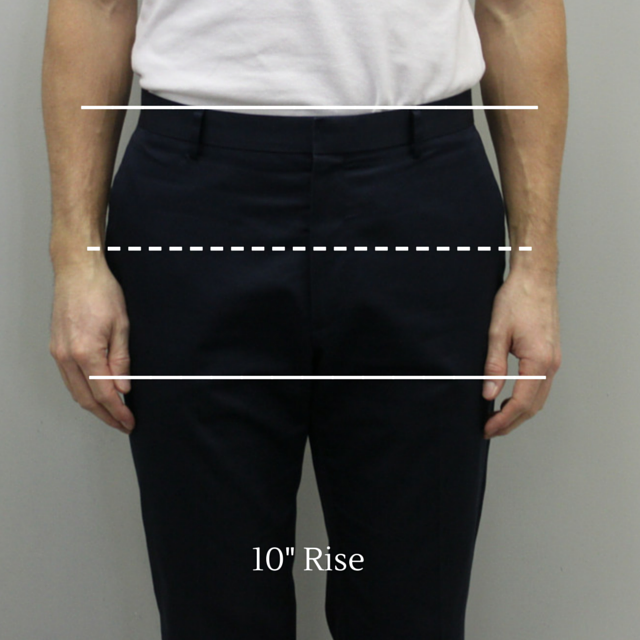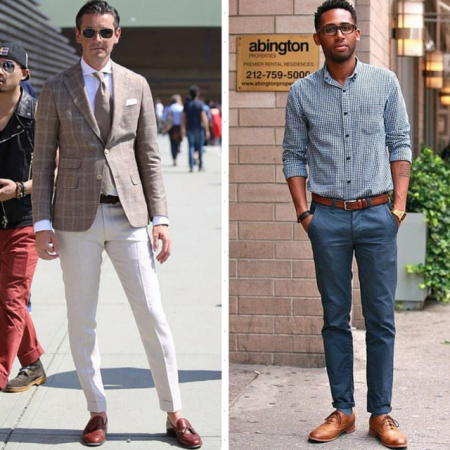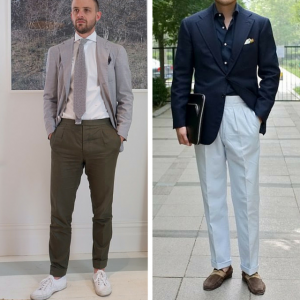Pants are overlooked.
Their role is a supporting one; the jacket undeniably being the star lead. Even other supporting characters like shirts and accessories get more attention as easy ways to add a bit of pop to a look. No more – it’s time for pants to get their due!
Stylistically pants ground and set the tone for an outfit. They’re also the workhorse – you can undo a jacket or loosen a collar but a pant is always worn at its fullest. For these reasons a perfect fitting pant is crucial. This is the first in a three-part series on how to achieve exactly that perfection.
Part I – Get the rise right.
What is the rise?
The rise is the distance between the top of the waistband and the bottom of the crotch. To determine the rise; subtract the length of the in-seam measurement from that of the out-seam. Generally the difference will be between 9-12 inches.
The rise is crucial because it determines where the pants waistband will sit on your body, which in turn creates your perceived waistline. I say “perceived” because by playing with the rise you are able to alter the proportional relationship between your torso and legs.
What is meant by a low or high rise pant?
We’ll use the Navy pant above as our starting point – it’s an example of a 10 inch rise which is standard for men’s tailoring. Now imagine cutting horizontally along the dotted line between the waistband and the crotch. With this cut we could hypothetically open it up and add more length; as such the waistband moves up, the bottom of the crotch moves down and the rise gets longer or higher as it’s commonly described. Conversely we could also remove length to shorten the rise; in this case the waistband moves down, the bottom of the crotch moves up and the rise gets lower.
The images below show the results of this process – the Grey pant on the left is a more traditionally cut 10.5 inch rise; the Olive pant on the right being a more contemporary 9.5 inch rise. As you can see the “perceived” waistline is very different.
Impact of the rise: on style
The three examples shown above clearly show the visual impact that different rise lengths have on the wearers mid-section. This in turn effects the visual length of the torso and the legs – below are some full body examples to show the influence of this proportional relationship:
Shorter Rise
Right away you should notice the longer appearance of the torso with a shorter rise. The effect is countered though by the base of the crotch being higher which acts to elongate the legs. These two counter points play off each other to create a very delicate balance – get it wrong and your proportions can start to look very odd. Those of you with long legs and a shorter torso can go this route without worry. Everyone else needs to play with this a little to find out what works best for them.
Longer Rise
With this set of images you’ll notice that the torso doesn’t appear a great deal shorter; not at least when compared to the elongation that occurred with the shorter rise. This is simply because a longer rise mimics the natural shape of our bodies hence less visual manipulation.
What is noticeable is a greater sense of length along the outside of the leg; it’s an effect that is countered though by the base of the crotch being set lower. The result is a balanced overall appearance that is applicable to the widest range of body types. Those of you with a short torso should avoid the longest rises; a medium length will provide the right balance. Everyone else should be playing with it to find what works best for them.
Impact of the rise: on comfort
Unquestionably a higher sitting pant is more comfortable than one that sits lower on the hips. Our hips are the body’s main pivot point and are in constant motion – when the waistband sits at this point there is nothing it can do but move which in turns causes tugging, pulling and general discomfort. With the waistband on the natural waist it sits in a place that has very minimal movement hence greater comfort.
That said most of us are willing to sacrifice a little comfort for style in certain situations. In making this decision it simply comes down to your body type – I’ll use myself as a reference point. My years in the squat rack have given me the classic “hockey butt” that many of you are familiar with. Mine is particularly troublesome because I have a very developed upper seat – the result being it pushes the waistband upwards making a lower sitting pant very uncomfortable. As such a higher sitting pant is more comfortable as it allows for more fullness to be introduced into the upper seat area as it is a more gradual increase in circumference from the waistband itself.
So guys with a hockey butts – I’m afraid a shorter rise is likely not your best option from a comfort point of view. For those of you with flatter or more medium proportioned seats it’s an option that is absolutely open to you. The key is to try different styles on and get a sense what works for you. in doing so make sure you walk around the room for a few minutes as opposed to just standing still in front of the mirror – this movement will determine what happens at the waistband and the level of comfort that occurs with it thus guiding your decision making process.
The takeaway:
The proportional relationship between the torso and the legs is a very personal matter. What looks right to one person may look completely odd to the next. This post was not about hard rules rather it’s aim was to make you think and look at the choices out there with a new sense of what might work best for your body. Likely you’ll be like me and enjoy having a few different lengths in your arsenal.
As always let me know if you have any questions or comments – take care.
Michael
info@martinfishertailors.com










